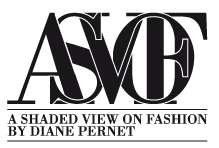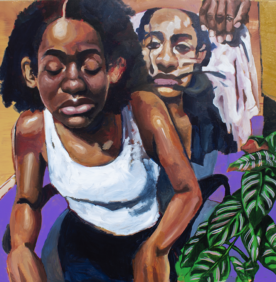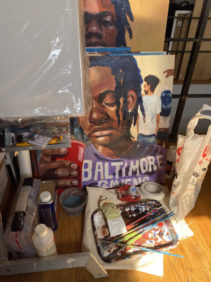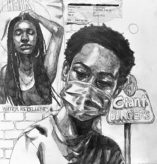Dear Shaded Viewers,
I discovered the work of artist Julian Alexander through Arts Thread, below is our conversation.
DP: Aside from the quality of the portraits what strikes me the most is the emotion that they transmit, when did you start painting and how has it evolved over the years?
JA: I’ve been drawing for as long as I can remember, but I started painting in high school when I was 16 years old. I’m 22 now. My first painting class in high school was really challenging to me because I didn’t take to it as easily as some of the other kids in the class. Then in my senior year of college, my professors told me to paint in the same way I draw. Not to be so concerned with filling in a painting and making it look smooth and realistic. My drawings captured a sketchy and immediate quality. I had to get the lines in as fast as possible to capture the emotion of the moment. Once I started to view painting and drawing as the same thing, then I really got into painting. Most of the work I’m actually proud of happened in my senior year of college.
DP: Did you grow up in the inner city of NYC? Have you personally experienced attacks on your person because you are black? I mean this outside of a protest march.
JA: I grew up between Brooklyn, New York and Bloomfield, Connecticut. My parents are divorced so I bounced back and forth between those two cities. I claim that I’m from both places because they’re so different, and represent very different sides of myself. In Connecticut, the city I grew up in was mostly black. I went to school with mostly black people, and was around mostly black people. When I was in Brooklyn, it was more mixed, and that’s when I actually began to understand racism more and form a unique perspective on it. I’ve experienced so much racism (both targeted attacks and microaggressions) within New York City that it frustrates me when people say New York is a melting pot. It’s diverse, but I wouldn’t call it a melting pot. There are definitely neighborhoods I wouldn’t hang out in at night specifically because I am black. There’s a lot of people that exist in the same city but are very segregated from each other.
DP: Do you feel that this time the protests were moved the dial a bit more than in the past or not? You covered your face with a scarf as opposed to a mask was that because you did not want to feel silenced?
JA: I feel the protests gained more attention because people were already at home and didn’t have anything else to draw their attention to. People had to sit with themselves and realize that while they were living their lives, this has been happening the whole time. I definitely hope that people stay active once they’re able to return to their day to day lives, because throughout my entire life I’ve been living with these anxieties, but eventually the cycle repeats itself.
DP: You say that you also covered your face not to be identified, did you feel that you would be on some kind of a list if you were identified? I hate to even ask, but how close to reality is that?
JA: As far as covering yourself up, I just know what police do. I know people get grabbed from protests and disappear. I remember getting dropped off at a movie theater with my friends as a kid and being told by my grandfather to be careful because we were black boys. I’ve always known what happens, and while I recognize that there’s a need to go out there and let your voice be heard, safety is my utmost priority.
DP: Have the writings and the documentary I Am Not Your Negro, James Baldwin resonated with you?
JA: James Baldwin’s quote “The word negro is used to disguise the fact one is talking about another man. A man like you.” is one of the primary concerns of my artwork. It bothers me when people say “black art”. It implies that somehow, art made by a black person is different inherently and doesn’t deal with the same spectrum of human emotion that is assumed by white artists. People refuse to engage with it, and they assume they know what it’s about already. My work isn’t about black people, my work is about the human experience. Why are the figures black? Because I’m black, and my emotions are just as complex as anyone else’s.
DP: Who are your heroes? Steve McQueen, the artist and filmmaker by any chance? Anyone come to mind that has impacted your work or/and inspired you?
JA: Stylistically, the primary people who inspire my work right now are Lynette Yiadom-Boakye and Takehiko Inoue. I’m also really proud of and inspired by my peers. The artists that I work alongside and can just pick up the phone to call are really important in driving me to keep going. Some of these people are Cameron Gipson (@stoic_lotus), Radhia Rahman (@knivesmeow), Kaya Balugo (@rad.kaya) , Emmanual Massillon (@massi____), Alfred Dudley III (@artmaps), and Alvin Armstrong (@eyesrevive). There are tons of others that I don’t even have the space to name, but I genuinely draw a lot of my energy from knowing that these people are in my corner and seeing the stories they tell in their work feeds back into mine. I strongly recommend anyone reading this to check them out. I would also like to shout out all of the artists at The School of Visual Arts’ Black Student Union. Every single one of y’all are so important to giving me a real sense of community at school, and I love seeing you all work hard and shine.
DP: Do you think there is any hope in America as far as racism and police brutality is concerned?
JA: As far as police brutality goes, I have hope that it can be potentially curbed with legislation, but we are never going to solve racism. We have to exist in spite of it. Legislation won’t fix hate. We need to do the inner work on ourselves alongside the community work. Direct action, voting, and being informed are all great things to get involved with. I also stress that it is equally important to confront our own internal biases.
DP: Social media has shined the light on something that has been going on for decades, do you think of that as a force for change?
JA: I think social media can definitely be used to bring change because it makes it easier to organize. Now the average person has all the information in the world in the palm of their hands, and can reach out to anyone they want to. That’s definitely a big power shift.
DP: With the final results of the election in, well, not acknowledged by Trump of course, do you feel even the slightest ray of light?
JA: I know we’ve avoided a lot of terrible situations by voting out Trump. The rest is on us to keep the same energy we have been, both inside and outside the systems of voting.
DP: What comes next for you?
JA: I’m always going to be documenting my experience, so I have plans of making artwork for the rest of my life. It doesn’t matter so much where the art lives. I’m trying to do editorial illustration, fine art for galleries, album artwork, really I’ll do anything. In terms of tangible goals, I want to get a solo show one day. I also want to buy a home. I really want to teach and mentor someone younger than me. Even if they don’t end up becoming an artist, I think the position of teaching and sharing experiences is very important.













